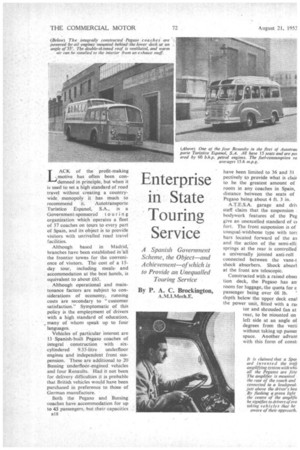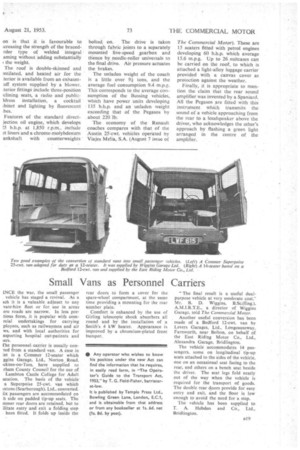Enterprise • in State Touring Service
Page 52

Page 53

If you've noticed an error in this article please click here to report it so we can fix it.
A Spanish Government Scheme, the Object—and Achievement—of which is to Provide an Unequalled Touring Service By P. A. C. Brockington,
L.. ACK of the . profit-making motive has• often been condemned in principle, but when it is used to set a high standard of road travel without creating a countrywide • monopoly it has much to recommend it. Autotransporte Turistico Espanol, S.A., is a Government-sponsored touring organization which operates a fleet of 37 coaches on tours to every part of Spain, and its object is to provide visitors with unrivalled road travel facilities.
Although based in Madrid, branches have been established in{'all the frontier towns for the convenience of visitors. The cost of a 15day tour, including meals ■ and accommodation at the best hotels, is equivalent to about £65.
Although operational and maintenance factors are subject to considerations of economy, running costs are secondary to "customer satisfaction." Symptomatic of this policy is the employment of drivers with a high standard of education, . many of whom speak up to four languages.
Vehicles of particular interest are 13 Spanish-built Pegaso coaches of integral construction with sixcylindered 9.35-litre underfloor engines and independent front suspension. These are additional to 20. Bussing underfloorengined vehicles and four Renaults. Had it not been for delivery difficulties it is probable that British vehicles would have been purchased in preference to those of German manufacture.
Both the Pegaso and Bussing coaches have accommodation for up to 45 passengers, but their capacities al8 have been limited to 36 and 31 pectively to provide what is clair to be the greatest amount of room in any coaches in Spain, distance between the seats of Pegaso being about 4 ft. 3 in.
A.T.E.S.A. garage and driA staff claim that the suspension . bodywork features of the Peg give an unexcelled standard of cc fort. The front suspension is of unequal-wishbone type with tor bars located forward of the ax and the action of the semi-elli. springs at the rear is controlled a universally jointed anti-roll connected between the vane-t
shock absorbers. Shock absorl at the front are telescopic.
Constructed with a raised obset tion deck, the Pegaso has an room for luggage, the quota for e passenger being over 66 lb. ' depth below the upper deck enal the power unit, fitted with a rad tor and shrouded fan at rear, to be Mounted on left side at an angle of degrees from the verti without taking up passer space. Another advani with this form of con sti on is that it is favourable to [creasing the strength of the bracedrder type of welded integral aming without adding substantially the weight.
The roof is double-skinned and :ntilated, and heated air for the tenor is available from an exhaustWI system supplied by a blower. tenor fittings include three-position chning seats, a radio and publicidress installation, a cocktail tbinet and lighting by fluorescent ,bes.
Features of the standard directjection oil engine, which develops 15 b.h.p. at 1,850 r.p.m., include at liners and a chrome-molybdenum ankshaft with counterweights bolted, on. The drive is taken through fabric joints to a separately mounted five-speed gearbox and tlience by needle-roller universals to the final drive. Air pressure actuates the brakes.
The unladen weight of the coach is a little over 91tons, and the average fuel consumption 9.4 m.p.g. This corresponds to the average consumption of the Bussing vehicles, which have power units developing 135 b.h.p. and an unladen weight exceeding that of the Pegasos by about 220 lb.
The economy of the Renault coaches compares with that of the Austin 25-cwt. vehicles operated by Viajes Melia, S.A. (August 7 issue of
The Commercial Motor). These are 15 seaters fitted with petrol engines developing 60 b.h.p. which average 15.6 m.p.g. Up to 26 suitcases can be carried on the roof, to which is attached a light-alloy luggage carrier provided with a canvas cover as protection against the weather.
Finally, it is appropriate to mention the claim that the rear sound amplifier was invented by a Spaniard. All the Pegasos are fitted with this instrument which transmits the sound of a vehicle approaching from the rear to a -loudspeaker above the driver, who acknowledges the other's approach by flashing a green light arranged in the centre of the amplifier.




























































































